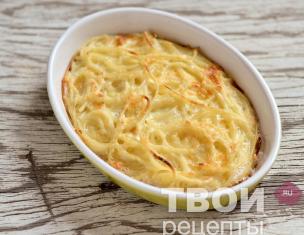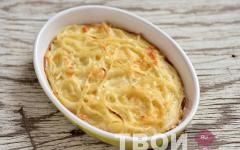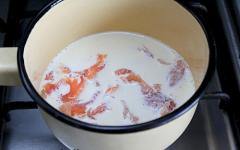If your child is skeptical about this dish, there is a way to spark interest. Tell me that Harry Potter himself ate the pie. Baking with kidneys is actually mentioned in JK Rowling's book.
Photo: Lori's photo bank, globallookpress.comFor 7 - 8 servings/495 kcal each.
Necessary:
400 g beef kidneys · 600 g beef · 2 onions · 10 champignons · 300 g puff pastry · 2.5 - 3 cups beef broth · 2 tbsp. tablespoons flour · vegetable oil · salt · ground pepper.
Cooking:
We wash the kidneys and fill them with clean water. Soak for at least 4 hours, changing the water every hour. Cut the kidneys into small pieces, remove fat, films and ducts. We wash the beef and chop it.
Peel the onion and chop it. Fry in vegetable oil until transparent. Add beef, cook until golden brown. Place on a plate. Place the kidneys into the frying pan and fry as well.
Place the kidneys and meat with onions in a saucepan. Sprinkle with flour and pour in broth. Cook for 1.5 - 2 hours until thickened.
At this time, wash, peel and cut the champignons. Place in a frying pan with vegetable oil and simmer until the liquid evaporates. Transfer the mushrooms to the prepared kidneys and meat. Season with salt and pepper. Let the filling cool and transfer to a baking dish.
Roll out the puff pastry into a round layer. Cover the pie pan, fold the edges in, and cut off the excess dough. We make a small hole in the center. Beat the egg and brush the pie. Cook for 15 - 20 minutes in the oven preheated to 220 °C, and the same amount at 180 °C.

Bud.
Cut in half lengthwise. Cut out fat and connective tissue. Cut into 2x2 cm cubes. Approximately like this. 
Place the kidney in a saucepan, fill with cold water, and bring to a boil. We drain the water, wash the kidney and the pan, repeat the water procedure and then dry the kidney so that it can be fried.
Meat.
Beef must be selected from a cut suitable for stewing.
In such cases, I prefer a spatula, and not just a spatula, but a certain part, which, in my opinion, is ideal for stewing. 
We also cut the meat into cubes.
Heat the fat, fry the kidneys and meat with onions. Before frying, sprinkle the meat with a small amount of flour.
Season with salt and pepper (I used black and English), add parsley (I preferred thyme), pour in a small amount of beef broth and simmer until the condition we need (taking into account the fact that the meat will still be baked). I didn’t stew at all - this cut, in my opinion and taste, does not need long-term stewing.
I set it to cool - the hot meat will not allow the dough to bake.
Dough.
About the dough it is said - any kind.
We recommend shortbread or puff pastry, prepared according to the same recipe and differing in the rolling method.
125 gr. flour +125 gr. cold oil + 1/4 tsp. Chop salt into fine crumbs, add 3-4 tbsp. l. very cold water and form into a ball.
Cool thoroughly.
Further:
- simply roll out to obtain shortcrust pastry
- roll out 3 times, folding and cooling (using the puff pastry method) to obtain a puff pastry.
I made the dough using this recipe and therefore I can recommend both methods. The second, although more labor-intensive, makes the dough tastier.
I had ready-made dough that needed to be used - this is also an option.
It is recommended to use a flat mold, so that the meat lies in a heap above the sides; the dough should cover the meat with a heap, and not fall inside. Cover the meat with dough, press the lid to the sides of the mold, cut a hole for steam, brush with egg and bake until the dough is ready at 200C. 
When serving, it is recommended to cut the crust, separate it and place it on plates, and then arrange the meat.
My husband's verdict: "Very tasty, but not enough dough!"
Indeed, not enough. But I don’t know how to solve this problem?!
Do you love English cuisine as much as I do? Perhaps this question will sound strange to many. Right off the bat, it’s hard for me to remember another country whose culinary tradition would be so unlucky with its image and PR support. Now it is probably difficult to trace how and at what point the concept of “English cuisine” became a worldwide synonym for tasteless food. And the lack of understanding of the historical background only aggravates my frustration - I am sincerely perplexed: how could this happen?! Because, it seems to me, only a person who judges it by fish & chips, oatmeal and other similar replicated cliches can call English cuisine bad, tasteless and even more so uninteresting. A slightly deeper acquaintance with the topic radically changes the attitude towards it: the neophyte discovers so many beautiful original things that there is nothing to even compare with. On the other hand, many modern Englishmen do not seem to be patriotic about their culinary traditions either. Here I don’t even know what to think - perhaps these are just unfortunate children who did not have the right English grandmother.
David Shepherd "Granny's Kitchen"
One way or another, I am convinced that the statement “English cuisine is the worst cuisine in the world” is nothing more than a myth. Blindly replicated and generated primarily by ignorance and unwillingness to understand. Less often, perhaps also due to a discrepancy in tastes. They say about English cuisine, in particular, that it is too heavy, fatty, etc., but the same can be said about literally any national cuisine, in its original, traditional form. This was the specificity of those distant times when all culinary traditions were born: people strived for high calorie content, and before the advent of the fashion for healthy eating, life was not the simplest for many centuries. Today, under the influence of modern trends, many cuisines around the world are becoming healthier to one degree or another, and English is no exception. But I still love it not for this, but for some special comfort that traditional English dishes bring to the house, regardless of their calorie content. In my perception, English cuisine is very warm and very homely. The most homely one you can imagine. And the British are probably the best at cooking meat. To my taste, of course.
I have long wanted to make a small contribution to debunking the myth of English cuisine. I have enough literary sources for this at my disposal (and the English classic writers are perhaps my very, very favorite). But in the pages of classic novels, descriptions of food tend to be scattered and rather sparse, and it is not always possible to easily find any particular dish. What to do if you want to talk about him? One fine day I found a universal solution for myself. They turned out to be books about Harry Potter. Not a classic, of course, in the traditional sense of the word, but... in a certain, narrow sense, it’s also a classic.
This was a real discovery for me. Of course, I remembered how generous J. K. Rowling was with her descriptions of feasts, but I read the books themselves a long time ago, as they were published, and then all the names of dishes found in them did not mean anything to me. And then it suddenly turned out that Rowling feeds her heroes exclusively traditional English food - in all its richness and variety. Thus, now it is not difficult to find a quote that illustrates the story of almost any classic English dish. Which, of course, I won’t fail to take advantage of. Don't consider it a scam :)
Of course, in the case of Harry Potter, consistently cooking everything that the characters eat throughout the seven volumes of their adventures would be a truly suicidal decision. So here I will deviate from the established tradition. It would be better from time to time, depending on the mood, to talk about some individual dishes, alternating them with food from other books.
Once at Hogwarts, Harry, who had never before had the opportunity to eat for pleasure or even just eat his fill, finds himself in a real gastronomic paradise. He and his friends, like most children of the same age, have no problems with appetite, so we can feast with the heroes and enjoy with them all the richness of the dishes that appear on the tables. Many of them, however, are mentioned without much detail, and besides, something regularly prevents the heroes from enjoying especially coveted delicacies: either something unexpected happens that interrupts the meal, or they simply lose their appetite due to some serious shocks. However, sometimes, on the contrary, they eat away their troubles with their favorite food. Be that as it may, I now greet every new mention of a dish of English cuisine as if it were an old acquaintance - with joy and tenderness. I want it to be the same for you :)
As part of the English culinary tradition, I really like savory dishes involving dough - primarily all kinds of pies and puddings. I once wrote about puddings, but my knowledge at that time was quite fragmented, and it was only about sweet options. It's time to expand on the topic a little.
As for savory pies, this is a special song. In the traditional version, they are very far from pies as we understand them. This is simply a meat (or some other) filling baked in a deep dish under a dough lid. This type of pie eliminates the need for careful portion cutting - it is placed with a spoon, along with the aromatic sauce in which the filling was stewed, and supplemented with a corresponding piece of dough, that is, a lid. True, portioned pies are now baked in a version with a bottom and walls made of dough, but I prefer the old-fashioned version. For me, such pies are the quintessence of English cuisine. However, I can say the same thing about many other things :)
Today I want to introduce you to two related dishes - pudding and pie, which are based on virtually the same filling: beef and beef kidneys. They are distinguished from each other primarily by their shape and method of preparation. Pudding is a shell of soft suet pastry filled with a rich filling. It is prepared in a water bath, and it takes a long time - several hours. A pie is a relatively deep pan filled with filling and topped with a layer of pastry. It is baked in the oven and it doesn't take much time. True, the preliminary heat treatment of the meat requires more time: it (the meat) needs to be stewed properly. The dough, in principle, can be different. The classic version still uses fat, but you can also use simple puff pastry, even ready-made.
The original names of these dishes are steak and kidney pudding And steak and kidney pie. Word steak indicates that back in the 19th century, it was not customary for them to finely cut meat - in fact, it was one or two large pieces of beef that were stewed whole in dough, with the addition of various auxiliary ingredients. This is evidenced by the quote from Mrs. Beeton, which you will find below (as part of the description of the pie). But over time, English housewives came to the conclusion that cutting meat into pieces gives the best result, and this approach became entrenched in culinary practice.
Also, oysters were originally a classic addition to beef, but over time, beef kidneys took their place and have since become a traditional component.
In Harry Potter, pudding is mentioned a couple of times only in passing, and even then, as I already said, the characters are always prevented from trying it. Pie was a little luckier in this regard. But they were both unlucky with translations into Russian :) The most common case is when steak is translated as something separate, and then in the text we get, for example, “steak and kidney pie.” In general, it seems that even within the same book, the names of the same dishes can easily be spelled differently. So it’s good when you have the opportunity, if not to read the original, then at least check it :)
Steak and Kidney Pudding
- What is this? Ron asked, pointing to a large dish of what looked like a seafood stew behind a large beef and kidney pudding.
"Harry Potter and the Goblet of Fire"
In this quote, Ron refers to the bouillabaisse prepared for the arrival of guests from France. But first of all, we’ll talk about pudding :)
When I want to bolster my knowledge of classic British cuisine with information from a credible source, my first port of call is always Mrs. Beeton's hefty volume of Mrs. I have already written Beeton’s Book of Household Management more than once, literally at every opportunity. It’s probably high time for me to expand the list of my sources. But there are no special incentives, because this one has never let me down yet. So, what writes about beef and kidney pudding, the most authoritative author of the Victorian era?She offers two recipes: the first is a cooking technique closer to the pie, and the second is the pudding itself in the classical sense of the word.
Mrs. Beeton's original recipes (Mrs. Beeton's Book of Household Management, 1861)
Baked beef pudding
INGREDIENTS. 6 ounces flour, 2 eggs, half a pint of milk, salt to taste, 1.5 pounds of beef (rump), 1 kidney, salt and pepper.
COOKING. Cut the beef into neat cubes with a little fat, and divide the kidney into small pieces. Prepare a batter of flour, eggs and milk, taken in the above proportions. Pour some into the bottom of the pie pan in a thin layer. Place the pieces of beef and kidneys on top, seasoned well with pepper and salt, and cover with the remaining dough. Bake for 1-1.5 hours in a moderately hot oven.
Beef and kidney pudding
INGREDIENTS. 2 pounds beef (rump), 2 kidneys, salt and pepper to taste, kidney fat dough with milk (see Dough section), in the proportion of 6 ounces of fat to every pound of flour.
COOKING. Buy a tender rump of beef (that's been hanging out for a little while), and cut it into cubes about an inch wide; Cut each kidney into 8 pieces. Line the dish with dough made from fat and flour in the above proportions, leaving a small piece of dough to cover. Then cover the bottom with a portion of beef and a few pieces of kidney; sprinkle with salt and pepper (some people add a little flour to thicken the sauce, but this is not necessary); make another layer of beef, kidneys, salt and pepper. Do this until the dish is full. Then pour in enough water to come within about 2 inches of the top of the pan. Moisten the edges of the dough, cover the pudding, seal carefully to prevent the sauce from escaping, and tuck in any excess dough. Soak a piece of cloth in hot water and wring it out, sprinkle it with flour and tie the pudding in it. Place in boiling water and leave to cook for at least 4 hours. If the amount of water decreases, always replenish it with hot water from the mug, as the pudding should be covered with it at all times, and it should not stop boiling. After removing the cloth, cut a round piece from the top of the dough to prevent the pudding from bursting, and serve in a bowl or on a decorative platter, lined with a napkin. Serve quickly.
Note. Beef pudding can be greatly enriched by adding a few oysters or mushrooms. The above recipe was furnished for this work by a lady from Sussex, and the inhabitants of this county are famous for their savory puddings. It differs from the basic cooking method in that the meat is cut into very small pieces and the base bowl is shaped differently - the result is a much better pudding, with more sauce, than when large pieces of meat are placed in the dish.
As we can see, Mrs. Beeton suggests putting the filling into the pudding raw, without prior preparation. A more modern recipe that I want to introduce you to involves pre-frying the ingredients (without long simmering). It also contains onions and spices, and uses stout and beef broth instead of water. In general, the taste is richer. Well, it’s still more convenient to cook pudding in a heat-resistant form than in a piece of cloth.
They were the first to arrive for lunch in the Great Hall, hoping to see Hagrid, but he was not there.
“They won’t kick him out, will they?” “Hermione said anxiously, not even touching her beef and kidney pudding.
“Probably not,” said Ron, who also hadn’t eaten.
"Harry Potter and the prisoner of Azkaban"
Just before this scene, Hagrid, in his first lesson, introduced the students to the hippogriff, and Malfoy, with his behavior, provoked this proud animal to show aggression. It is not surprising that Ron and Hermione were so worried about the future fate of their newly minted teacher. But still, a good piece of pudding with beef and kidneys could smooth out their worries a little.
Beef and kidney pudding
1 liter pudding mold
Dough ingredients
375g self-raising flour*
½ tsp. salt
130 g kidney fat (finely chopped or grated)**
~200 ml cold water
Filling ingredients
2 tbsp. l. vegetable oil
130 g beef kidneys (cut into cubes)
600 g beef shoulder (cut into cubes with a side of about 2 cm)
1 onion (peel and finely chop)
½ tbsp. l. flour
1 tsp. with a heap of dry thyme
1 large bay leaf
2 tbsp. l. Worcestershire sauce
130 ml stout
130 ml beef broth, boiled to jelly***
Salt
Freshly ground black pepper
*The classic version uses plain wheat flour, but self-rising flour produces a softer dough, which when finished is perfectly soaked in sauce - it turns out very tasty. You can take plain flour and add 1.5 tsp. baking powder.
**Kidney fat (suet) is a classic British product, and suet pastry is a classic dough based on it for British cuisine. I have already written about both. Of course, kidney fat in the dough can be replaced, for example, with butter (slightly softened). But this will be a different dough. And the main thing to consider is that with such a replacement you will need less water, you need to be guided by the consistency of the dough.
***Cm. recipe below. If cooking such a broth seems too monumental to you, you can, in principle, replace it with simple beef or chicken, but for the correct texture of the sauce, add more flour to the filling than indicated in the recipe. Of course, this is an inferior replacement in terms of taste and aroma, but technically it works quite well.
Preparation

1. Sift flour and salt into a large bowl.
2. Add the fat and stir until it is evenly distributed in the flour.
3. Pour in half the water.
4. Using a fork, knead the dough, working gently but quickly. Then we work with our fingertips, trying to knit the dough together. At the same time, little by little, as needed, add the remaining water. As a result, the dough should become homogeneous and smooth, without dry inclusions of flour.
5. Cover the bowl with a towel and let it rest for 10 minutes.
6. Roll out two thirds of the dough into a layer and line the pudding pan with it. We put it in the refrigerator.
7. Roll out the remaining third of the dough into a circle of sufficient diameter to make a lid for the pudding. Transfer to a plate, cover with cling film and also put in the refrigerator.

8. Place the frying pan on high heat and heat 1 tbsp. l. oils Add chopped kidneys and fry until browned. Transfer from the pan to a separate dish and set aside.
9. Add the remaining oil to the pan, heat it up and fry the beef in it. The pieces of meat should not fit tightly to each other (otherwise they will release juice), so if the frying pan is not large enough, they can be fried in portions, in several stages.
10. Add finely chopped onion to the meat, reduce heat and cook for about 10 minutes until the onion becomes soft and translucent.
11. Sprinkle with salt and flour, add thyme, bay leaf, Worcestershire sauce, and ½ tsp. ground black pepper. Cook, stirring, for about 5 minutes.
12. Add pre-fried kidneys, stout and broth. Stir and remove from heat. Cool (this is important, because if the hot filling has a premature heat effect on the chilled dough, it may turn out too hard).

13. Place the cold filling in the prepared pan with the base. Lightly moisten the edges of the dough with water, cover the pudding with the remaining dough lid and seal properly.
14. To cover the pan with the pudding, cut out a piece of parchment paper of sufficient size, in the middle of which you need to make a fold so that during the cooking process there is enough space for steam under this “lid”, otherwise it may tear it. Prepare a similar piece of foil. We cover the mold first with paper, then with foil, bend their edges to the outside of the mold and tie them tightly with kitchen thread. It is worth making a loop on top from the same thread so that it is convenient to remove the pudding from a pan of hot water.
15. Take a pan of sufficient size, place a metal ring on the bottom for cutting out dough (or something similar) and place the form with pudding on this ring. You can simply lay a thick piece of fabric so that the mold does not come into direct contact with the pan.
16. Carefully pour boiling water into the pan so that it reaches 2/3 of the height of the pudding pan. Bring to a boil, reduce heat to low and cover the pan with a lid. Cook the pudding for 4 hours, adding boiling water as needed.
17. After 4 hours, remove the pan from the water, remove the foil and paper, cover the pan with a warm serving dish and carefully turn the pudding onto it.
Serve hot; steamed vegetables are a good addition. Raw ones are fine too.
If you let the pudding sit for a while before cutting, the sauce will become thicker and will not flow out as intensely as in my photo. If you cool the pudding completely, you can generally cut it into neat pieces. But it still tastes better hot, and when heated, the neat pieces will fall apart one way or another, because the jelly-like sauce holding them together will become liquid again.



Jelly beef broth
The recipe is designed to yield two liters of this product, and I present it here in its original form. But for pudding we only need 130 ml, so I made half. I don’t even have such a huge pan.
Ingredients
5 kg beef or veal bones
4 tbsp. l. vegetable oil
1 large carrot (roughly chop)
1 stalk of celery (roughly chop)
1 large onion (roughly chop)
3 cloves garlic (clear)
1 bay leaf
100 g large mushrooms or mushroom trimmings (roughly chop)*
1 tomato (roughly chop)
300 ml light red wine
1 pork leg (cut in half)
Small bunch of thyme
Sprig of tarragon
1 tsp. black peppercorns
*Instead of fresh mushrooms during cooking, I added a couple of pieces of dried white mushrooms to the broth along with the spices.
Preparation

1. Preheat the oven to 220 ºС. Place the bones on a baking sheet (or baking sheets) and place in the oven. Bake for 1 hour, turning the bones occasionally so they brown evenly.
2. Pour vegetable oil into the bottom of the pan and place it on medium heat. Add carrots, celery, onion and cook, stirring, for 10-15 minutes.
3. Add mushrooms, tomato, garlic and bay leaf, and cook until this vegetable mixture becomes dry and begins to stick to the bottom of the pan.
4. Pour in red wine and cook until it has evaporated by half.
5. Add the pork leg, half the beef bones and 2 liters of cold water. Mix it all well and add the remaining bones and another 4 liters of water.
6. Increase the heat and bring the water to a low boil. Carefully remove the foam. When it stops appearing, add the remaining spices.
7. Leave the pan on low heat at a low simmer for 12 hours.
8. Strain through a very fine sieve (it is better to line it with gauze or cotton cloth folded several times). Leave to cool overnight.
9. In the morning, remove the congealed fat from the surface of the broth, and put the pan with the broth back on the fire. Boil until 2 liters of broth remains. Remove from heat and cool.
10. Distribute the cold broth into portioned containers and freeze everything that we do not plan to use in the near future. Can be stored in the freezer for up to two months.
If you then defrost this preparation and dilute it with water in a 1:1 ratio, you will simply get a strong beef broth, which you can use, for example, to cook soup. And in concentrated form it is used in many traditional British recipes.
Steak and Kidney Pie
- Are you kidding…
This was at lunch. Harry had just finished telling Ron what happened when Professor McGonagall led him away from the site. While he spoke, Ron was enthusiastically eating his beef and kidney pie. But now that Harry had finished, he completely forgot about the pie, never getting the last piece into his mouth.
- Catcher? There was surprise in Ron's voice. - But first-years will never... You will probably become the youngest player in the history of Hogwarts in...
“...over the last hundred years,” Harry finished for him, taking the pie with gusto. After what he had experienced this afternoon, he was terribly hungry. “Wood already told me that.”
"Harry Potter and the Philosopher's Stone"
The beef and kidney pie on the pages of JK Rowling's books is a little luckier than the pudding: they appear more often, and the characters get to it more often. I think you will also find it more accessible. However, plot twists and turns often prevented the heroes from appreciating the taste of this dish. For example, as when Harry appears at dinner after Umbridge's sadistic punishment:
“At least it’s good that you just need to write,” Hermione tried to console him when Harry sank back into his place at the table and looked at the beef and kidney pie, which he no longer wanted to finish. - This is not such a terrible punishment...
"Harry Potter and the Order of the Phoenix"
If we look back into history, we find that the tradition of using such a filling in a pie rather than in a pudding is probably more recent. At least in Mrs. Beeton we find only a recipe for a simple beef pie, and the kidneys are not even mentioned in the notes.
Mrs. Beeton's original recipe (Mrs. Beeton's Book of Household Management, 1861)
Beef pie
INGREDIENTS. 3 pounds beef (rump), salt to taste, cayenne pepper, black pepper, dough, water, egg yolk.
COOKING. Take pieces of meat cut from a rump that has been hanging for several days, as this meat can be tender, and be picky to ensure that each portion is perfectly fresh. Cut the meat into pieces about 3 inches long by 2 inches wide, adding a small piece of fat to each lean piece, and layer the meat in a pie dish. Sprinkle each layer with salt, black pepper, and, if desired, a few grains of cayenne pepper. The dish must be filled with enough meat so that it supports the dough lid and the latter, after baking, has a nice bulge and does not look flat or sunken. Pour in enough water to fill the dish halfway and seal it with dough (see Dough section): Brush a piece of dough with a little water and cover the dish with it, then press the edges with your thumb and trim the excess dough close to the dish. Decorate the pie with leaves or pieces of dough cut into any shape your imagination allows; brush with beaten egg yolk. Make a hole in the center of the dough and bake in a hot oven for 1-1.5 hours.
Note. Beef pies can be flavored in a variety of ways: oysters and their liquid, mushrooms, chopped onions, etc. In homemade pies, suet can be used in the dough instead of butter or lard and solve the issue of hydrating the beef when economy is important. Pieces of undercooked or cooked meat can be used very advantageously in a pie; but always remove the bones from the pie meat, unless it is chicken or game. We specified that the meat should be cut smaller than usual, as when cooked we found it more tender, easier to eat and with more sauce than when it was put into the dish as one or two large steaks.
Having swallowed their breakfast, they went up to the lobby - Kreacher greeted them with bows and a promise to prepare a beef and kidney pie for their return.
“He’s so cute,” Ron said lovingly, “but I wanted to cut off his head and pin it to the wall.”
"Harry Potter and the Deathly Hallows"
Beef and kidney pie
Ingredients
2 tbsp. l. vegetable oil
700 g beef for stewing (cut into cubes)
200 g beef kidneys (cut into cubes)
2 medium onions (cut finely)
30 g flour
850 ml beef broth
Salt and freshly ground black pepper to taste
1 tsp. Worcestershire sauce
300 g puff pastry
1 egg yolk mixed with 1 tbsp. l. milk (for brushing dough)
Preparation

1. Heat vegetable oil in a large frying pan and fry the kidneys over high heat. Transfer to a bowl and set aside.
2. In the same frying pan, fry the pieces of meat on all sides until golden brown (in several batches if the frying pan is not large enough).
3. Add the onion and cook with the meat for a few minutes.
4. Return the pre-fried kidneys to the pan.
5. Sprinkle the contents of the pan with flour so that it coats it evenly.
6. Add broth, mix thoroughly and bring to a boil.
7. Reduce the heat to low and simmer without a lid for 1.5 hours. If necessary, add additional broth or just water. Towards the end, the contents of the pan need to be stirred from time to time, as the sauce thickens greatly and the mixture may begin to burn.
8. Remove from heat. Add salt, pepper and Worcestershire sauce, stir and let cool slightly.
9. Transfer the finished filling into a pie dish.

10. Preheat the oven to 220°C.
11. Roll out the dough into a layer 5 mm thick. Its radius should be larger than that of the pie pan you are using.
12. Cover the pie with dough, trim off the excess and seal carefully. Cut a hole in the center to allow steam to escape.
13. Grease the top of the pie with the egg-milk mixture.
14. Use scraps of dough to make decorations to your liking. We place them on the lid of the pie and also grease them with yolk and milk.
15. Place in the oven and bake for 30-40 minutes.
Serve with steamed green peas and carrots. The pie, like pudding, can be allowed to sit for a while before slicing so that the filling “sets” a little, but here this is not so critical, since the sauce is not so liquid to begin with.


There was no point in pretending - Harry had no doubt that Hermione was right. And this was a serious blow. If the Yaxleys managed to get inside the house, they won't be able to return to Grimmauld Place. Already now he could call other Death Eaters to the house, and they would transgress there. No matter how gloomy and depressing this house was, it was their only safe haven, and besides, Kreacher had now become more cheerful and friendly. With a regret that had nothing to do with food, Harry imagined the house elf fussing over the beef and kidney pie they would never eat again.
"Harry Potter and the Deathly Hallows"
In such a situation, one can only sympathize with the heroes. And my sympathy has everything to do with food!


- Great, Ron! - Hermione exclaimed.
- Well? said Ron indignantly, finally swallowing his food. - You can’t ask a simple question, can you?
“Oh, forget it,” Hermione replied irritably, and they spent the rest of dinner sulking angrily at each other.
Harry was already so used to their quarrels that he didn’t even make an attempt to reconcile them; he decided that his time would be better spent on a beef and kidney pie, followed by a large slice of his favorite treacle pie.
"Harry Potter and the Order of the Phoenix"
I’ll tell you about the treacle pie some other time, but I’ll tell you about what these pies and puddings are washed down with in the magical world in the coming days :) Fortunately, there’s been a reason for a long time.









